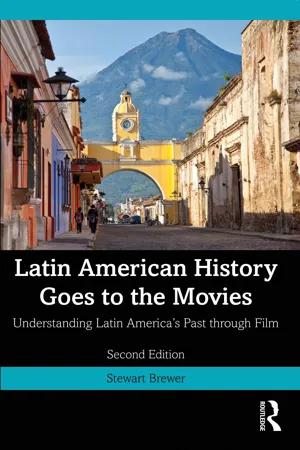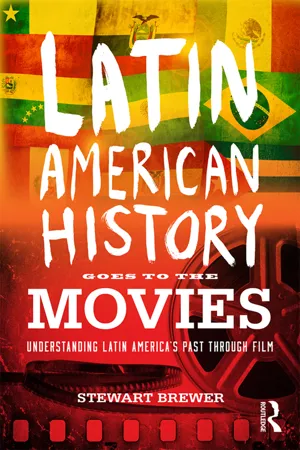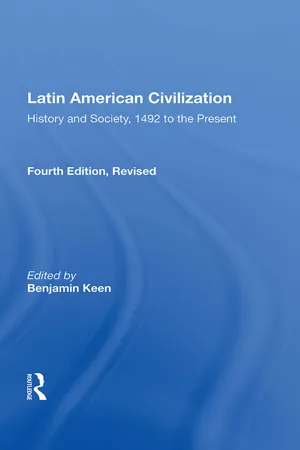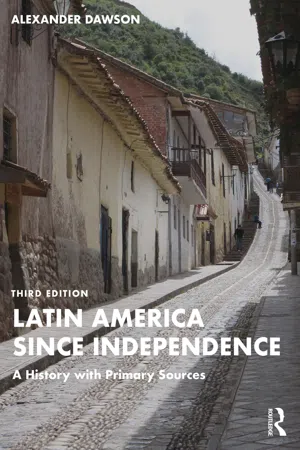History
Latin American Revolution
The Latin American Revolution refers to the series of independence movements that took place in the early 19th century, leading to the liberation of Latin American countries from Spanish and Portuguese colonial rule. Influenced by Enlightenment ideals and inspired by the American and French Revolutions, leaders such as Simón Bolívar and José de San Martín played pivotal roles in the struggle for independence.
Written by Perlego with AI-assistance
Related key terms
7 Key excerpts on "Latin American Revolution"
- eBook - ePub
Latin American History Goes to the Movies
Understanding Latin America's Past through Film
- Stewart Brewer(Author)
- 2024(Publication Date)
- Routledge(Publisher)
7 Revolutionary Latin AmericaDOI: 10.4324/9781003285526-7Republican Government is over-perfect, and it demands political virtues and talents far superior to our own. For the same reason, I reject a monarchy that is part aristocracy and part democracy …. Do not adopt the best system of government, but the one which is most likely to succeed.There is no good faith in America, nor among the nations of America. Treaties are only scraps of paper; constitutions are only printed matter; elections, battles, freedom, anarchy, and life are all a torment. America is ungovernable. Those who have served the revolution have plowed the sea.Simón BolívarThe Wars for Independence
Revolution and seeking for freedom through revolutionary violence has been endemic in Latin America throughout much of its history. Revolution is a level of rapid change at a basic level, and is usually associated with some sort of violence. In the early decades of the nineteenth century, the colonies in Latin America waged vehement revolutions, both political and social, for freedom from their status as colonies of Spain and Portugal. Indeed, throughout the nineteenth century and into the twentieth, revolutions, motivated by various struggles, would punctuate movements throughout Latin America, from Mexico to Argentina, most of which were fierce and came at the cost of thousands of lives.Revolutions can be divided into the very broad categories of political and social. Political revolutions use violence to suddenly transform political systems while at the same time trying to not interrupt the underlying structure of society too dramatically. Having said this, some historical political revolutions have not only transformed political systems, they have also significantly altered entire populations through a liberation of some kind.By contrast, social revolutions are responsible for creating massive changes in the economic and cultural infrastructure of a nation or state. Whereas political revolutions change the structure at the top, social revolutions empower the masses. Also, social revolutions tend to be bloodier and more violent than political revolutions because the masses are involved in securing their new freedoms, and social revolutions are more likely to begin when political revolutions fail or become unstable. - No longer available |Learn more
Latin American History Goes to the Movies
Understanding Latin America's Past through Film
- Stewart Brewer(Author)
- 2015(Publication Date)
- Routledge(Publisher)
Revolutionary Latin AmericaRepublican Government is over-perfect, and it demands political virtues and talents far superior to our own. For the same reason, I reject a monarchy that is part aristocracy and part democracy… Do not adopt the best system of government, but the one which is most likely to succeed.There is no good faith in America, nor among the nations of America. Treaties are only scraps of paper; constitutions are only printed matter; elections, battles, freedom, anarchy, and life are all a torment. America is ungovernable. Those who have served the revolution have plowed the sea.Simón BolívarThe Wars for Independence
Revolution and seeking for freedom through revolutionary violence has been endemic in Latin America throughout much of its history. Revolution is a level of rapid change at a basic level, and is usually associated with some sort of violence. In the early decades of the nineteenth century, the colonies in Latin America waged vehement revolutions, both political and social, for freedom from their status as colonies of Spain and Portugal. Indeed, throughout the nineteenth century and into the twentieth, revolutions, motivated by various struggles, would punctuate movements throughout Latin America, from Mexico to Argentina, most of which were fierce and came at the cost of thousands of lives.Revolutions can be divided into the very broad categories of political and social. Political revolutions use violence to suddenly transform political systems while at the same time trying to not interrupt the underlying structure of society too dramatically. Having said this, some historical political revolutions have not only transformed political systems, they have also significantly altered entire populations through a liberation of some kind.By contrast, social revolutions are responsible for creating massive changes in the economic and cultural infrastructure of a nation or state. Whereas political revolutions change the structure at the top, social revolutions empower the masses. Also, social revolutions tend to be bloodier and more violent than political revolutions because the masses are involved in securing their new freedoms, and social revolutions are more likely to begin when political revolutions fail or become unstable. - Claire Taylor, Thea Pitman(Authors)
- 2013(Publication Date)
- Routledge(Publisher)
6 ‘ Revolución.com? The Latin American Revolutionary Tradition in the Age of New Media (Revolutions) The association of Latin America, and by extension Latin American-ness, with the concept of revolution is both long-standing and, this final chapter contends, a feature of Latin American cultural identity that has arguably seen the most substantial efforts at resemanticisation and reinvigoration in online cultural production, prompted both by contemporary political situations of differing sorts, as well as by the coincidence of the concept of ‘revolution’ in a sociopolitical sense with what is rather more loosely termed a ‘revolution’ in new media technologies—their invention per se as well as their practical deployment to promote social change. This association of Latin America and revolutionary projects is well documented and, depending on the source, highlights from this trajectory may stretch from the Independence Wars of the nineteenth century, through the Mexican Revolution (1910–20), the Cuban Revolution (1959-) and the Nicaraguan Revolution (1979–90), to the uprising orchestrated by the Ejército Zapatista de Liberación Nacional in Chiapas in 1994, the Bolivarian Revolution in Venezuela (1998-) and other more recent social movements. While more sceptical critics warn that ‘the stereotype that vindicates the natural right of these lands to revolution’ is ‘unproductive’ (Herlinghaus 2004:563), other more ardent admirers of Latin American Revolutionary projects still claim that Latin America ‘was and is the world region which has generated the most original and vigorous popular and revolutionary movements’ (Raby 2006:x). Steering a less partisan course, in Art and Revolution in Latin America, 1910–1990 David Craven seeks to identify exactly what Latin America has contributed to the meaning of the term ‘revolution’ in its traditional late twentieth-century (but pre-internet) usage- eBook - ePub
Latin American Civilization
History And Society, 1492 To The Present-- Fourth Edition
- Benjamin Keen(Author)
- 2019(Publication Date)
- Routledge(Publisher)
Latin America in the Nineteenth CenturyPassage contains an image
Chapter XIIIThe Liberation of Latin AmericaMany factors combined to cause the Latin American Wars of Independence. The discontent of the Creole class with Spanish restrictions on its economic and political activity, the influence of French and English liberal doctrines, the powerful example of the American and French Revolutions, and foreign interest in the liquidation of the Spanish empire in the Americas-all played a part in producing the great upheaval.The immediate cause of the Spanish American revolutions was the occupation of Spain by French troops in 1808. Napoleon’s intervention provoked an uprising of the Spanish people, headed by juntas , or local governing committees. Creole leaders in the colonies soon took advantage of Spain’s distresses. Professing loyalty to “the beloved Ferdinand VII,” a prisoner in France, they forced the removal of allegedly unreliable Spanish officials and formed governing juntas to rule in the name of the captive king. Their claims of loyalty did not convince the Spanish authorities, and fighting soon broke out between patriots and loyalists.Simón Bolívar led the struggle for independence in northern South America, and José de San Martín directed the military efforts of the patriots to the south. In 1822 the enigmatic San Martín resigned command of his army, leaving to Bolívar the task of completing the conquest of Peru, the last Spanish stronghold in the New World The battle of Ayacucho, won by Sucre, virtually ended the war. Brazil achieved a relatively peaceful separation from Portugal in 1822, under the leadership of Prince Pedro and his adviser José Bonifacio de Andrada.The Mexican Revolution, initiated in 1810 by the Creole priest Miguel Hidalgo, was continued after his death by another liberal curate, José Maria Morelos. These men attempted to combine the Creole ideal of independence with a program of social reform in behalf of the Indian and mixed-blood masses. The radicalism of Hidalgo and Morelos alienated many Creole conservatives, who joined the royalist forces to suppress the revolt. Later, fearing the loss of their privileges as a result of the liberal revolution of 1820 in Spain, the same conservative coalition schemed to bring about a separation from Spain. They found an agent in the ambitious Creole officer Agustin de Iturbide. His Plan of lguala offered a compromise solution temporarily acceptable to liberals and conservatives, to Creoles and many Spaniards. Slight loyalist opposition was swiftly overcome, and in September 1822, a national congress proclaimed the independence of the Mexican empire. - eBook - ePub
- Gavin O'Toole(Author)
- 2017(Publication Date)
- Routledge(Publisher)
In Argentina, military hardliners began a purge against Peronists. In Brazil, Vargas’s populist government was destroyed in 1954 by the irreconcilable demands of unions and industrialists and he committed suicide. Competition also developed between those advocating social reform and those who believed in more radical change. In Bolivia, the populist Movimiento Nacionalista Revolucionario (MNR, Revolutionary Nationalist Movement) took power in 1952 and pursued nationalist policies influenced by positions deriving from Marxism – a political philosophy advocating the achievement of workers’ control of the means of production through revolution – to destroy the power of the traditional landed elites and mining interests. Although some countries such as Colombia, Venezuela, Costa Rica, Mexico, Chile, and Uruguay were able to keep political differences under control, by the late 1950s much of Latin America had become mired in conflicts between rival social groups, divided as to what direction their countries should take. Until the 1960s, Marxism had played only a limited role in the evolution of Latin American politics, largely because the industrial working class was small and communist parties believed peasants would not be an important vector of revolution (see Box 12.1). However, the success of the Cuban Revolution in 1959 (see Box 2.3) challenged reformist perspectives and inspired armed revolts in Paraguay, Argentina, and the Dominican Republic (1959); Venezuela and Colombia (1961); Guatemala and Ecuador (1962); and Peru (1963). CASE STUDY Box 2.3 The Cuban Revolution The Cuban Revolution in 1959 was a turning point in the Cold War because it linked nationalist resistance to ‘US imperialism’ with insurgency and transformed the prospects of socialism in Latin America (see Chapters 9, 10, 12, 13, 14 ; Box 10.8). The revolution was the only successful armed insurgency in the region until the Sandinistas seized power in Nicaragua two decades later (see below) - eBook - ePub
Latin America since Independence
A History with Primary Sources
- Alexander Dawson(Author)
- 2022(Publication Date)
- Routledge(Publisher)
These challenges might lead us to abandon both the idea of a common independence narrative and a sense that there can be a common story of Latin America. Yet if we do this, we risk losing sight of a significant fact: between 1790 and 1830 almost every colony in the Americas (excepting Canada, Cuba, and a small number of other colonies in or bordering the Caribbean) violently dispossessed their European rulers. A shared history of colonial rule marked all of these societies and left common legacies and challenges for most. Moreover, the battles for independence connected societies across the region. News of rebellions in one colony spread to others, as did rebel and imperial armies. The fact that different parts of the region were under the control of different empires also facilitated the process, as rebel leaders moved between empires (thus Bolívar’s Letter from Jamaica, excerpted below), and could at times enlist the support of the European enemies of their colonial overlords. With Europe consumed by the Napoleonic Wars, rebels in the colonies found unprecedented opportunities to seize power for themselves.These phenomena leave us with a series of uncomfortable choices. If we choose one independence narrative, we are given a chance to imagine a common Latin American past at the risk of silencing other, equally valid ways of understanding this history. If we choose too many narratives, we do greater justice to personal and local stories at the risk of losing a larger view of Latin America in the cacophony. My approach to this dilemma is twofold. Below I will tell three stories of independence instead of one. And rather than considering independence as a series of heroes and events to be remembered and venerated, the sections that follow focus on the ways that independence is narrated—the morals and messages that are usually invoked through the story of Latin American Independence.Stories of Freedom
On 4 November 1780, in the Andean town of Tinta, Túpac Amaru II (José Gabriel Candorcanqui) seized the local Spanish Governor, Antonio de Arriaga, and ordered that he be put on trial. Executing de Arriaga a week later, he declared a rebellion against the Spanish Empire. His rebellion failed, leading to his death and the deaths of thousands of his compatriots. Though short lived, the cathartic (or alternately, frightening) power of his rebellion resonates in much of Latin America to this day. In part because he took his name from the last Inca ruler to be conquered by the Spaniards, and in part because he called for the expulsion of Spaniards from the Americas, the 1780 revolt has long been an inspiration to those battling racial inequality across the hemisphere. - eBook - ePub
New World Studies
From Their Origins through the Nineteenth Century
- Earl E. Fitz(Author)
- 2023(Publication Date)
- University of Virginia Press(Publisher)
In the eighteenth century, the American political context was changing fast, and with it inter-American relations. Issues of influence and reception were developing that hitherto had not been seen. Latin Americans watched carefully the political drama that was gaining momentum in the United States and would come to a head in the US war for independence. Earlier, with the defeat of the Spanish Armada, in 1588, the power of the Spanish Empire had begun to erode. As a consequence of this, Spain’s ability to control the destiny of its distant American colonies begins to decline as well. Growing sclerotic, the old Spanish Empire was weakening and increasingly unable to control its vast New World possessions. People in Spanish America were chafing at Spanish control. Its growing creole class was particularly restive.The US experience with England only spurred this process on in Spanish America. As the original thirteen colonies of British North America grew increasingly militant about their status and identity, they would rise up in revolt and in 1776 win their war of independence. An English colony became the United States of America. The meaning of this momentous event was not lost on the Latin Americans. Indeed, the social, political, and economic repercussions of US independence were felt throughout Spanish America and Brazil. The winds of change were blowing hard in the Americas.In 1789, a Brazilian delegation was dispatched to Paris to discuss with the US plenipotentiary there, Thomas Jefferson, how the United States might respond if Brazil were to overthrow its monarchy and replace it with a democratic form of government. Jefferson responded that while the United States would be sympathetic to the Brazilian cause, it was not in a position to formally recognize and support such an effort. Disappointed, the Brazilians returned home. But inspired by events in the United States, revolutionary sentiment was still strong in Brazil. In 1789, with the ill-fated Inconfidência Mineira, it experienced its first attempt at independence. The rebellion, with a group of poets playing a prominent part, was put down and its participants punished. But the seeds of independence had been sown.
Index pages curate the most relevant extracts from our library of academic textbooks. They’ve been created using an in-house natural language model (NLM), each adding context and meaning to key research topics.






